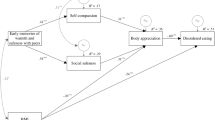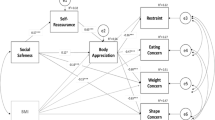Abstract
Literature suggested that the recall of early positive experiences have a major impact on the promotion of feelings of connectedness and social safeness, and seems to protect individuals against psychopathology. Recent research has also demonstrated that the absence of these positive rearing memories play a key role on disordered eating-related behaviours. The impact of early affiliative memories on disordered eating do not seem to be direct, and the mechanisms underlying this relationship are scarcely investigated. The present study aimed to clarify how memories of warmth and safeness explain the adoption of disordered eating attitudes, and tested the mediator role of social safeness, external shame and appearance-focused social comparison on aforementioned relationship, in a sample of 277 young women. The tested model explained 36% of eating psychopathology’s variance and presented an excellent fit. Path analysis results indicated that the impact of rearing memories on eating psychopathology was fully mediated through the mechanisms of social safeness, external shame and appearance-focused social comparison. Specifically, these findings suggested that the extent to which positive rearing memories are associated with lower levels of disordered eating attitudes is influenced by the current feelings of social safeness and connectedness, which in turn are totally carried by decreased feelings of external shame and by lower endorsement on unfavourable comparison based on physical appearance with proximal targets (peers). These results seem to offer important insights for research and clinical work on body image and eating-related difficulties, suggesting the relevance of promoting warm and safe interactions with others.
Level of evidence
Level V, descriptive study.

Similar content being viewed by others
References
Cacioppo JT, Berston GG, Sheridan JF, McClintock MK (2000) Multilevel integrative analysis of human behavior: Social neuroscience and the complementing nature of social and biological approaches. Psychol Bull 126:829–843. doi:10.1037/0033-2909.126.6.829
Mikulincer M, Shaver PR (2007) Attachment in adulthood: structure, dynamics, and change. Guilford, New York
Panksepp J (1998) Affective neuroscience. Oxford University Press, New York
Schore AN (2001) The effects of early relational trauma on right brain development, affect regulation, and infant mental health. Infant Ment Health J 22:201–269. doi:10.1002/1097-0355(200101/04)22:13.0.CO;2-9
Depue R, Morrone-Strupinsky J (2005) A neurobehavioral model of affiliative bonding. Behav Brain Sci 28:313–395. doi:10.1017/s0140525x05000063
Gilbert P (2005) Compassion and cruelty: a biopsychosocial approach. In: Gilbert P (ed) Compassion: conceptualisation, research and use in psychotherapy. Routledge, London, pp 9–74
Gilbert P (2009) The compassionate mind: a new approach to life’s challenges. Constable Robinson, London
Gilbert P (2010) Compassion focused therapy: distinctive features. Routledge, London
Wang S (2005) A conceptual framework for integrating research related to the physiology of compassion and the wisdom of Buddhist teachings. In: Gilbert P (ed) Compassion: conceptualisations, research and use in psychotherapy. Routledge, London, pp 75–120
Gilbert P (1989) Human nature and suffering. Lawrence Erlbaum Associates, Hove
Gilbert P, McEwan K, Mitra R, Franks L, Richter A, Rockliff H (2008) Feeling safe and content: a specific affect regulation system? Relationship to depression, anxiety, stress, and self-criticism. J Posit Psychol 3:182–191
Gilbert P (2002) Body shame: a biopsychosocial conceptualization and overview, with treatment implications. In: Gilbert P, Miles J (eds) Body shame: conceptualisation, research and treatment. Routledge, London, pp 3–54
Pinto Gouveia J, Matos M (2011) Can shame memories become a key to identity? The centrality of shame memories predicts psychopathology. Appl Cognit Psychol 25:281–290. doi:10.1002/acp1689
Richter A, Gilbert P, McEwan K (2009) Development of an early memories of warmth and safeness scale and its relationship to psychopathology. Psychol Psychother 82:171–184. doi:10.1348/147608308X395213
Baumeister RF, Leary MR (1995) The need to belong: desire for interpersonal attachments as a fundamental human motivation. Psychol Bull 117(3):497–529. doi:10.1037/0033-2909.117.3.497
Gilbert P, Price J, Allan S (1995) Social comparison, social attractiveness and evolution: how might they be related? N Ideas Psychol 13:149–165. doi:10.1016/0732-118X(95)00002-X
Ferreira C, Pinto Gouveia J, Duarte C (2013) Physical appearance as a measure of social ranking: the role of a new scale to understand the relationship between weight and dieting. Clin Psychol Psychother 20:55–66. doi:10.1002/cpp.769
Barkow J (1980) Prestige and self-esteem: A biosocial interpretation. In: Omark DR, Strayer FF, Freedman DG (eds) Dominance relations: an ethological view of human conflict and social interaction. Garland STPM Press, New York, pp 319–332
Gilbert P (1992) Depression: the evolution of powerlessness. Guilford/Lawrence Erlbaum Associates, Hove
Allan S, Gilbert P (1995) A social comparison scale: psychometric properties and relationship to psychopathology. Pers Individ Differ 19(3):293–299. doi:10.1016/0191-8869(95)00086-L
Troop NA, Allan S, Treasure JL, Katzman M (2003) Social comparison and submissive behaviour in eating disorders. Psychol Psychother Theory Res Pract 76:237–249. doi:10.1348/147608303322362479
Pinto Gouveia J, Ferreira C, Duarte C (2014) Thinness in the pursuit for social safeness: an integrative model of social rank mentality to explain eating psychopathology. Clin Psychol Psychother 21:154–165
Tangney JP, Dearing RL (2002) Shame and guilt. Guilford Press, New York
Gee A, Troop NN (2003) Shame, depressive symptoms and eating weight and shape concerns in a nonclinical sample. Eat Weight Disord 8(1):72–75. doi:10.1007/BF03324992
Kelly AC, Carter JC (2013) Why self-critical patients present with more severe eating disorder pathology: the mediating role of shame. Br J Clin Psychol 52(2):148–161
WHO (1995) Physical status: the use and interpretation of anthropometry. Reports of a WHO Expert Committee. WHO technical report series 854. World Health Organization, Geneva
Poínhos R, Franchini B, Afonso C, Correia F, Teixeira VH, Moreira P, Durão C, Pinho O, Silva D, Lima Reis JP, Veríssimo T, de Almeida MDV (2009) Alimentação e estilos de vida da população Portuguesa: metodologia e resultados preliminares [Alimentation and life styles of the Portuguese population: methodology and preliminary results]. Alimentação Humana 15(3):43–60
Gilbert P, McEwan K, Mitra R, Richter A, Franks L, Mills A, Bellew R, Gale C (2009) An exploration of different types of positive affect in students and in patients with bipolar disorders. Clin Neuropsychiatry 6:135–143
Goss K, Gilbert P, Allan S (1994) An exploration of shame measures––I: the ‘other as shamer’scale. Pers Individ Differ 17(5):713–717. doi:10.1016/0191-8869(94)90149-X
Fairburn CG, Beglin SJ (1994) Assessment of eating disorders: interview of self-report questionnaire? Int J Eat Disord 16(4):363–370. doi:10.1002/1098-108X(199412)16:4<363::AID-EAT2260160405>3.0.CO;2-#
Machado PP, Martins C, Vaz AR, Conceição E, Bastos AP, Gonçalves S (2014) Eating Disorder Examination Questionnaire: psychometric properties and norms for the Portuguese population. Euro Eat Disord Rev 22(6):448–453. doi:10.1002/erv.2318
Arbuckle JL (2006) Amos (version 7.0) (Computer Program). SPSS, Chicago
Kline RB (2005) Principles and practice of structural equation modeling, 2nd edn. The Guilford Press, New York
Mendes L, Marta-Simões J, Ferreira C (2016) How can the recall of early affiliative memories with peers influence on disordered eating behaviours? Eat Weight Disord. doi:10.1007/s40519-016-0267-7
Cunha M, Matos M, Faria D, Zagalo S (2012) Shame memories and psychopathology in adolescence: the mediator effect of shame. Int J Psychol Psychol Ther 12(2):203–218
Mendes AL, Ferreira C, Marta-Simões J (2016) Experiential avoidance versus decentering abilities: the role of different emotional processes on disordered eating. Eat Weight Disord Stud Anorex Bulim Obes. doi:10.1007/s40519-016-0291-7
Ferreira C, Pinto Gouveia J, Duarte C (2013) Drive for thinness as a women’s strategy to avoid inferiority. Int J Psychol Psychol Ther 13(1):15–29
Author information
Authors and Affiliations
Corresponding author
Ethics declarations
Ethical approval
All procedures performed in studies involving human participants were in accordance with the ethical standards of the institutional research committee and with the 1964 Helsinki declaration and its later amendments or comparable ethical standards.
Informed consent
Informed consent was obtained from all individual participants included in the study.
Conflict of interest
The authors of this manuscript declare no conflict of interest.
Rights and permissions
About this article
Cite this article
Ferreira, C., Silva, C., Mendes, A.L. et al. How do warmth, safeness and connectedness-related memories and experiences explain disordered eating?. Eat Weight Disord 23, 629–636 (2018). https://doi.org/10.1007/s40519-017-0449-y
Received:
Accepted:
Published:
Issue Date:
DOI: https://doi.org/10.1007/s40519-017-0449-y




